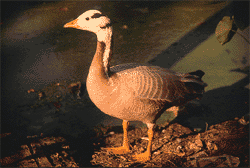Flying on the edge
 Not even the mighty Mount Everest can deter the flight of bar-headed geese. Every spring, gaggles of this world's highest-altitude migrants cross the Himalayan range as they migrate from their winter home in the low lands of India to their nesting abode in Tibet.
Not even the mighty Mount Everest can deter the flight of bar-headed geese. Every spring, gaggles of this world's highest-altitude migrants cross the Himalayan range as they migrate from their winter home in the low lands of India to their nesting abode in Tibet.
India is a winter terminus for several species of birds from central Asia. But for many of them breeding in northern areas and travelling to the south for the winter, the Himalayan mountain range is a major hurdle to migration. Satellite telemetry studies have shown that though many species of birds fly at elevations well above 5000 metres to cross the Himalayas, they take a circular route that greatly increases the distance and duration of their migration.
The bar-headed geese (Ancer Indicus) are, however, known for their ability to cross this formidable barrier with mountaineers reportedly having seen them flying at a height of approximately 9000 metres.
How do these migratory species survive in such conditions? According to Salim Javed, noted ornithologist who documented the migration of these birds, the ability of bar-headed geese to fly in a rarefied atmosphere comes from physiological adaptations. These geese have higher myoglobin concentration at the onset of migration and also slightly modified haemoglobin structure, which increases the oxygen binding capacity in them as compared to other migratory birds. This helps them withstand lower supply of oxygen.
Considering its stamina and tolerance for thin air, one might expect this bird to take the form of a giant lung. But it doesn't. Rather, its robust grey body, long neck, and short, tapered beak creates an elegant S-shaped silhouette. An adult goose weighs about five pounds and stands about two feet high. Two horizontal black stripes on the back of the bird's white head give the species its name.
Despite its fantastic aerobic powers, the ecology and distribution of this species is little studied, primarily because it is found in remote trans-border regions of central Asia that have limited access to ornithologists. In fact, the breeding grounds for the bar-headed geese wintering in India were never documented. It is also not certain whether the birds that breed in Ladakh spend the winter in the plains of India.
Facing extinction In the past, the geese have been known to enjoy considerable protection in Tibet afforded by the Buddhists. But now, due to their limited number and uncertain distribution, their conservation status has been listed as near threatened. Although hunting is prohibited under the Wildlife Protection Act of 1972 in India, the birds are victims of large-scale illegal hunting.
Continued loss and degradation of wetlands is another reason why the bar-headed geese like many other migratory water birds in India are on the decline. Threats to wetlands, the natural habitat of bar-headed geese, includes reclamation for agricultural, industrial, and urban expansion, and over exploitation of wetland resources.
The population of the bird is also at risk due to pesticide poisoning. V S Vijayan, noted ornithologist, says in his Keoladeo National Park (Bharatpur) Ecological Study (1991) that species such as bar-headed geese are at risk from pesticide contamination. He documented elevated levels of eldrin and dieldrin in sarus cranes (Grus Antigone) in support of his argument. The dieldrin levels in sarus cranes were higher than the lower limit of the diagnostic lethal level of dieldrin (4-5 parts per million) in the brain. As the mortality of all the birds around Bharatpur occurred during winter, which coincides with application of eldrin and dieldrin to protect the wheat and mustard crops from termites. This may have implications for the bar-headed geese and other winter migrants that use adjacent crop fields for feeding. Similar mortality was also reported in snow geese feeding on eldrin contaminated rice seeds in Texas. As the geese share the same feeding habits as these cranes, they may be exposed to the same contaminant.
Javed says that lack of baseline information is a major obstacle in the conservation of this species. "Starting a population monitoring programme using the network of bird organisations and individuals will provide vital information on the trends in the population,' says Javed. Ornithologists are of the view that a long term conservation programme including improved monitoring methods is key to save this magnificent bird which has conquered the mightiest of mountains and stores many clues within it for the unsolved avian mysteries.
